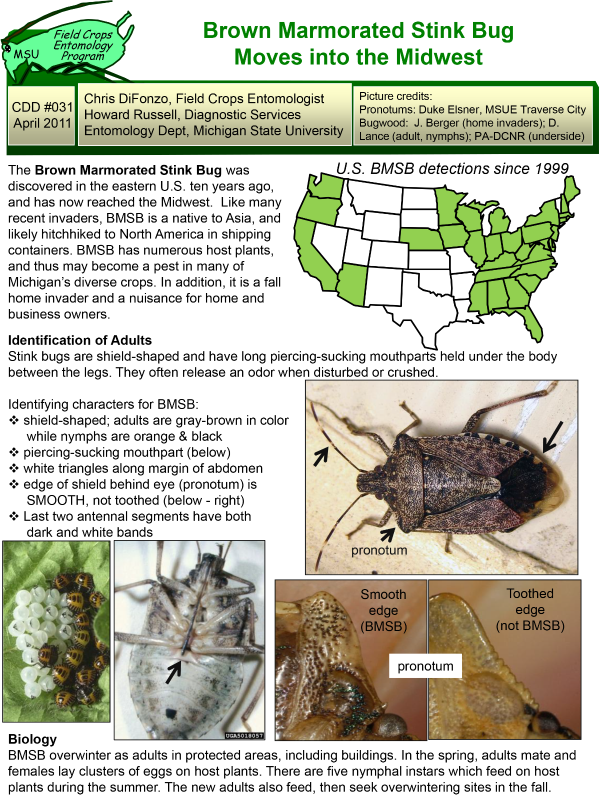
Brown Marmorated Stink Bug Moves in the Midwest
DOWNLOADApril 4, 2011 - Chris DiFonzo, Michigan State University Department of Entomology, and Howard Russell, MSU Plant & Pest Diagnostics
The Brown Marmorated Stink Bug was discovered in the eastern U.S. ten years ago, and has now reached the Midwest. Like many recent invaders, BMSB is a native to Asia, and likely hitchhiked to North America in shipping containers. BMSB has numerous host plants, and thus may become a pest in many of Michigan’s diverse crops. In addition, it is a fall home invader and a nuisance for home and business owners.
Identification of Adults
- Stink bugs are shield-shaped and have long piercing-sucking mouthparts held under the body between the legs. They often release an odor when disturbed or crushed.
- Identifying characters for BMSB:
- shield-shaped; adults are gray-brown in colorwhile nymphs are orange & black
- piercing-sucking mouthpart (below)
- white triangles along margin of abdomen
- edge of shield behind eye (pronotum) is SMOOTH, not toothed (below - right)
- Last two antennal segments have both dark and white bands
Biology
BMSB overwinter as adults in protected areas, including buildings. In the spring, adults mate and females lay clusters of eggs on host plants. There are five nymphal instars which feed on host plants during the summer. The new adults also feed, then seek overwintering sites in the fall.
Host range
There are many potential BMSB hosts among Michigan crops and ornamentals.
A few potential Michigan hosts include:
• fruits: apple, blackberry, blueberry, cherry, grape, pear, peach, raspberry
• vegetables: asparagus, green beans, peppers, sweet corn, tomato
• ornamentals/trees: basswood, butterfly bush, maple, redbud, walnut
• field crops: field and seed corn, soybean, probably dry beans
Damage potential
BMSB is a true bug, feeding on plant juices with a piercing-sucking mouthpart (right) and injecting saliva as it feeds. Unlike other sucking insects such as aphids, which feed gently without causing visible tissue damage, stink bugs puncture and scar plant tissue. Stink bugs may feed on leaves, stems, or blossoms, but often prefer tender new growth, developing seeds and fruits. This results in distortion of the growing tissue around the feeding scar, a symptom called ‘cat-facing’.
Field crops: Within a few years of discovery, BMSB numbers could increase and become a problem in field crops. In corn, BMSB feeds through the husk and damages the developing ear, resulting in unfilled or shrunken kernels. In soybean, BMSB feeds through the developing pod, resulting in aborted or shrunken seeds. Damage to dry beans is expected to be similar. Field crops may also be a concern if fields build large numbers of BMSB that then move into fruit and vegetable crops later in the season.
Fruits/ vegetables: From a yield loss/ economic standpoint, the impact of BMSB will likely be greatest in fruit and vegetable crops. Feeding results in scarring, cat-facing, and spotting of developing fruits and vegetables, reducing marketability.
Home invasion: The most common impact may be when potentially large numbers of stink bugs enter buildings in the fall, similar to our current situation with Asian ladybeetle and boxelder bugs. If smashed or disturbed, BMSB smell bad, but otherwise they are harmless. A vacuum cleaner can take care of the problem, in addition to filling cracks and fixing screens to prevent entry.
Note that there are other stink bug species in Michigan, and several common home invaders, some of which resemble brown marmorated stink bug. Right: boxelder bug, conifer seed bug, and rough stink bug.



 Print
Print Email
Email





